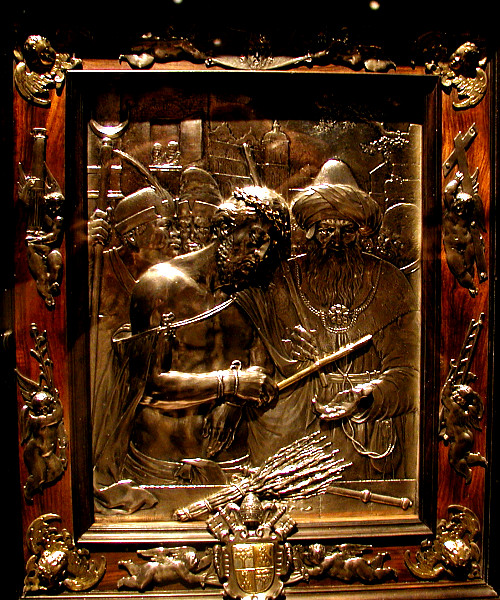
Ecce Homo
South German, first half of 17th century
Silver, rosewood, ebony; silver-gilt details on the frame
Metropolitan Museum of Art
The composition is a cross between an Ecce Homo (which normally presents Jesus alone to the viewer) and a full-scale narrative showing the moment after he is handed over to the Jews. He still wears the scarlet cloak and crown of thorns, and he still holds in his bound hands the reed the soldiers had given him. They had used it as a mock sceptre when they "crowned" him and then used it to beat him on the head (Matthew 27:29, Mark 15:19). Ironically carrying another reed as a sceptre, a Jewish official leads Jesus away from the praetorium, which is visible in the background. Over the official's left shoulder we see two onlookers from the crowd, and at his right are two of his attendants.
On the "sill" of the frame lie two objects that visually and symbolically carry the meaning of Christ's passion forward from history into the present time. A bundle of slender reeds lies bound into an aspergillum, the instrument a priest or deacon uses during the liturgy to sprinkle holy water on the congregation. As he does so, he will recite from Psalm 51 the words, "Thou shalt sprinkle me with hyssop, and I shall be cleansed." This cleansing was taken by the commentators to be "a type of the salvific passion of Christ" (Glossa Ordinaria, III, 802). The aspergillum rests on a "real" sceptre that echoes the two reeds of the inner image. The sceptre points directly to Jesus, most likely to claim him as the source of the authority of Alexander VII, the pope whose arms are at the bottom of the frame.
Putti on the outer frame carry the instruments of the Passion. Clockwise from the upper right they are the cross, the ladder and implements used to remove Jesus from the cross, the pole with the sponge (?), and the pillar where Jesus was scourged.
Read more about images of the trials of Jesus.
Photographed at the museum by Richard Stracke, shared under Attribution-NonCommercial-ShareAlike license.